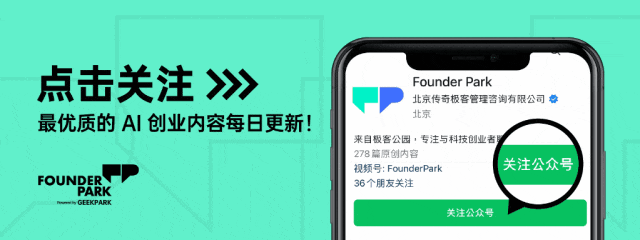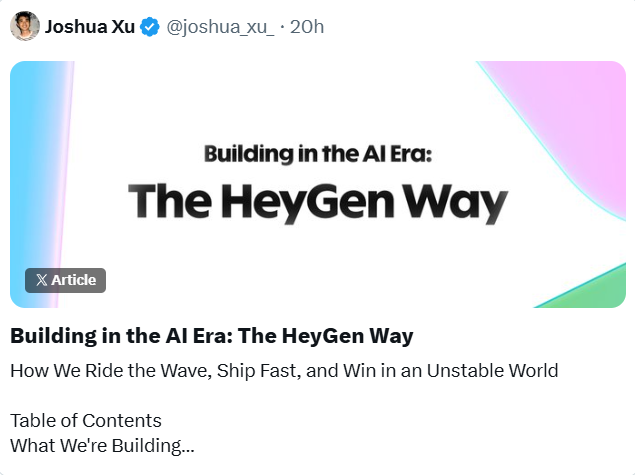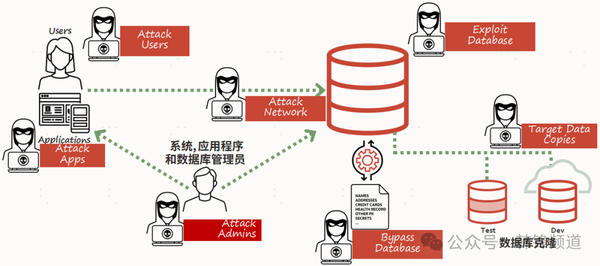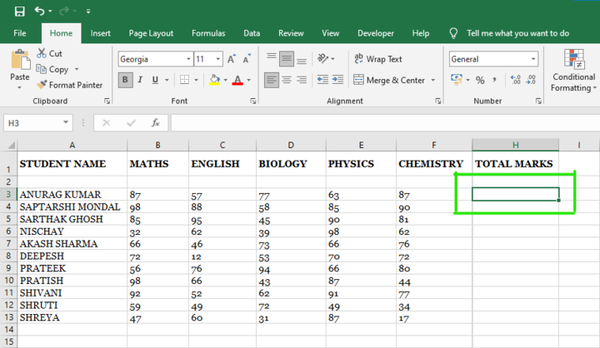# Founder Park — 2025‑10‑17 20:27 Beijing
---
## Joshua Xu: *Uncertainty Is Our Advantage*


Today, **HeyGen founder Joshua Xu** announced on X (Twitter) that the company reached **$100M in ARR** this month.
It took HeyGen **29 months** to grow from its first $1M ARR milestone to $100M.
---
## How Did They Make It Happen?
HeyGen’s answer: **Speed is everything.**
> Figure out what changes and what stays the same;
> Build products and systems around what remains constant;
> Ride the upside from model improvements.
Joshua Xu posted an AI startup *playbook* on X, describing:
- Internal thinking & collaboration strategy
- Decision‑making process
- How they release features **5× faster than competitors**
---

Below is the **full, slightly adapted** version compiled by *Founder Park* — worth a full read.
**Original link:** [https://x.com/joshua_xu_/article/1978837502787219578](https://x.com/joshua_xu_/article/1978837502787219578)
---
## Join a 15,000+ Member AI Product Marketplace Community
Don’t miss the best AI applications.
Industry professionals, developers, entrepreneurs — **scan the Feishu QR code** to join:

**Once you join, you’ll receive:**
- Latest noteworthy AI product updates
- Occasional invites & membership codes for trending products
- Accurate AI product exposure channels
---
## HeyGen’s Mission
> *Enable everyone to tell stories visually.*
Two categories of video:
- **Communication‑focused** — business updates, tutorials, interviews, product walkthroughs
*(Best edited with a script)*
- **Cinematic** — ads, films, music videos, trailers
*(Best edited on a timeline)*
**HeyGen focuses on the first type** — making it universally accessible to **all skill levels**.
---
## Why This Playbook?
Traditional software methods are dead.
In the AI era, breakthroughs happen every few months; what’s impossible today may be trivial tomorrow.
HeyGen builds **with AI’s trajectory**, not on a supposedly stable foundation.
This playbook explains **how we think, build, and win** — for teammates and future hires.
---
## 01 — Core Philosophy
### Embrace Uncertainty
> “Act fast, execute to the extreme. Ride the AI wave. Accept R&D uncertainty. Plan six months ahead. Build flexible products that grow with model upgrades — but never compromise on quality.”
---
### 1.1 Shift: From “Foundation” to “Wave”
- **AI tech changes radically every few months**
- We design products to **auto‑upgrade** with models
- Model instability is our opportunity
| Traditional Era | AI Era (HeyGen) |
|--------------------------|------------------------------|
| Build on solid foundation| Surf on technology wave |
| Plan 12–18 months ahead | Plan 2 months ahead |
| Perfect before shipping | Ship to learn |
| Step‑by‑step | Many experiments in parallel |
---
### 1.2 Different from Agile
Agile presumes a stable tech base; HeyGen iterates amid **constant upheaval**.
---
### 1.3 Surfer’s Advantage
- Identify **what changes** (models, capabilities)
- Identify **what stays** (user workflows, core pain points)
- Build around constants, enjoy model upgrades
---
### 1.4 Quality Paradox
Fast **and** best:
5× learning speed compounds into product advantage.
Speed exists to deliver quality sooner.
---
## 02 — Iteration Rhythm: Two‑Month Roadmap
### 2.1 Two‑Month Wave Cycle
- Plan roadmap every **two months** — matches AI model upgrade rhythm
- 6–12 month strategic foresight
- Biweekly commitment lists
- Daily releases
---
### 2.2 Surfing Experiment Steps
1. **Day 1:** Define hypothesis & success criteria
2. **Day 2:** Build MVP
3. **Days 3–5:** Release to small user set
4. **Week 2:** Analyze, decide next step
**Good Experiments:**
- Fast
- Data‑backed
- Clear signal — continue/pivot/stop
- Bold hypotheses
**Failed Experiments:**
- Most will fail — if you learned, it’s a win
---
### 2.3 Fast Decision Framework
- **One‑way door:** Rare, irreversible — slow & cautious
- **Two‑way door:** Common, reversible — decide & test quickly
**Communication:**
- Post decision in Slack
- Assign ownership & deadline
- Transparency & reasoning
---
### 2.4 Six-Month Bets
Align bets with AI development cycles. Build flexible architectures for future capabilities.
---
### 2.5 Manage Technical Debt Fast
- Assume all builds are replaceable
- Document assumptions
- Version control strictly
- Debt pay‑down = investment in future speed
---
## 03 — Guiding Principles: Speed Is Everything
### 3.1 Core Truth
Whoever learns fastest, wins.
**Execution Rules:**
- Launch in days
- Ship experiments when uncertain
- Imperfect but timely beats perfect but late
- Bugs block learning
---
### 3.2 Ride the Tech Wave
Design products to get better automatically with model upgrades.
---
### 3.3 Discuss Thoroughly, Execute Decisively
Once decided, commit — even if you disagreed initially.
---
### 3.4 User Value Through Innovation
Innovation must solve real problems.
Metric: **Average video quality achieved by any user**.
---
### 3.5 Build vs. Buy
- Build in‑house if quality demands (e.g., avatar video models)
- Buy if third‑party is “good enough” (e.g., voice models)
---
## 04 — Team Collaboration
Everyone understands **why we build**.
### Role Structure:
**PM:** Drives decisions, prototypes fast
**Engineer:** Rapid builder, flexible architectures
**Designer:** Masters of simplicity, “grandma test” usability
**Data Scientist:** Provide facts, validate experiments
---
**Collaboration Principles:**
- PMs → “What”
- Engineers → “How”
- Designers → Simplicity
- Data Scientists → Facts
- All → Agree on “Why”
---
**Prototype Workflow:**
1. PM/designer + engineer = prototype
2. Validate with users
3. Designer refines experience
4. Must meet launch-quality standard
---
## 05 — Core Product Team
Focus: Foundational product experience.
Traits: Longer dev cycles, extreme UX, design system consistency.
Standard: Absolute best experience.
Aim: Zero bugs.
---
## 06 — Growth Team
Purpose: Iteration speed.
**Principles:**
- Engineering = tool; impact = goal
- Learn via experiments, not “sure bets”
- Bias for action; ship; measure; adapt
---
## 07 — Communication
- **Async first**
- Few large meetings
- Immediate decision posting in Slack
- Direct feedback, focus on work not person
---
## 08 — Pitfalls to Avoid
Seven Deadly Sins:
1. Perfect architecture too early
2. Endless research w/o building
3. Waiting for stable foundation
4. Consensus trap
5. Quality as delay excuse
6. Big reveal launch after months
7. Sunk cost fallacy
---
**When to Actually Slow Down:**
- Blocks learning (bugs)
- Security issues
- UX‑damaging features
- Breaking changes for customers
- Major irreversible decisions
- User feedback shows wrong direction
- Compliance/legal issues
---
**Danger Signals:**
- “Let’s think more”
- “Need everyone to agree”
- “What if tech changes?”
- “Wait for next model”
- “We need more robust solution”
- “We can polish more”
---
## 09 — Why We Can Win
- Release speed = 5× competitors
- Faster learning compounds into superior products
- Uncertainty = advantage
- Focus on quality + speed + innovation
---
**Seven Principles:**
1. Move fast, no compromise
2. Build the best UX
3. Quality first
4. Discuss fully, execute decisively
5. Unsure? Experiment
6. Embrace unstable AI
7. Innovate via integration
---
## 10 — The Only Constant Is Change
> Cut false stability — ride the wave. Release fast, learn faster, win.
---

---
## Further Reading
- [Conversation with OPPO AI’s Jiang Yuchen](https://mp.weixin.qq.com/s?__biz=Mzg5NTc0MjgwMw==&mid=2247520122&idx=1&sn=76920ab7798f16bf520d3e085183f8ac&scene=21#wechat_redirect)
- [Inside Discussion with a Silicon Valley Founder](https://mp.weixin.qq.com/s?__biz=Mzg5NTc0MjgwMw==&mid=2247520041&idx=1&sn=5ac756a1d7f20eb376c77656d630e260&scene=21#wechat_redirect)
- [Figma Founder: MS‑DOS Era of AI Interaction](https://mp.weixin.qq.com/s?__biz=Mzg5NTc0MjgwMw==&mid=2247520164&idx=1&sn=a16b43e70100c49243eb6e4451afa688&scene=21#wechat_redirect)
- [The Biggest Problem in AI Startups](https://mp.weixin.qq.com/s?__biz=Mzg5NTc0MjgwMw==&mid=2247520071&idx=1&sn=68178ef5318c93373a361605688e5b98&scene=21#wechat_redirect)
---
**Key Takeaways:**
- **Be fast, but steady**
- **Creativity must integrate with execution**
- **Speed needs direction**
- **Act now, don’t overthink, go with the flow**





